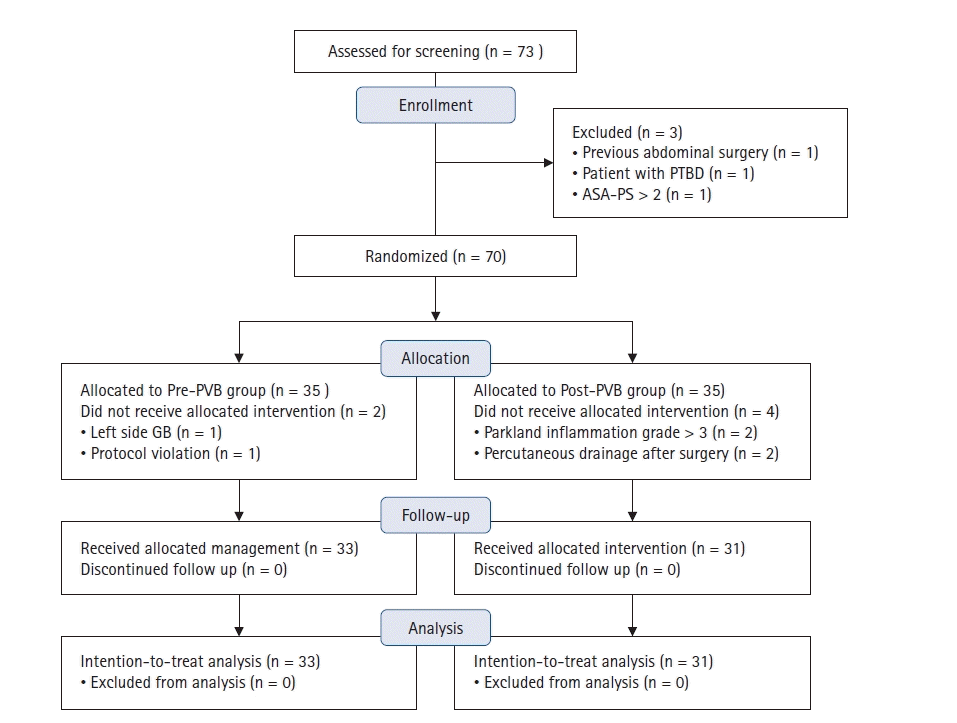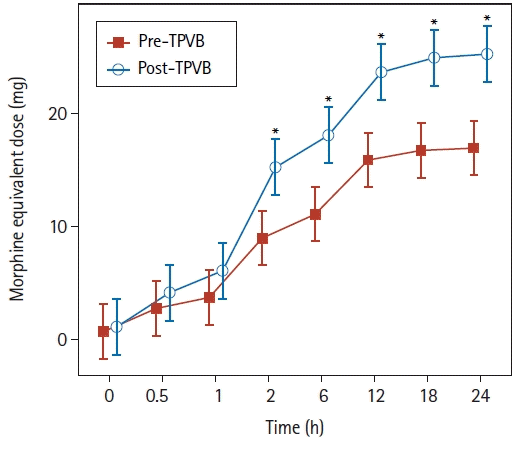1. Levy N, Quinlan J, El-Boghdadly K, Fawcett WJ, Agarwal V, Bastable RB, et al. An international multidisciplinary consensus statement on the prevention of opioid-related harm in adult surgical patients. Anaesthesia. 2021; 76:520–36.
2. Macintyre PE, Quinlan J, Levy N, Lobo DN. Current issues in the use of opioids for the management of postoperative pain: a review. JAMA Surg. 2022; 157:158–66.
3. Woolf CJ, Chong MS. Preemptive analgesia--treating postoperative pain by preventing the establishment of central sensitization. Anesth Analg. 1993; 77:362–79.
4. Kissin I. Preemptive analgesia. Anesthesiology. 2000; 93:1138–43.
5. Behdad A, Hosseinpour M, Khorasani P. Preemptive use of ketamine on post operative pain of appendectomy. Korean J Pain. 2011; 24:137–40.
6. Bugedo GJ, Cárcamo CR, Mertens RA, Dagnino JA, Muñoz HR. Preoperative percutaneous ilioinguinal and iliohypogastric nerve block with 0.5% bupivacaine for post-herniorrhaphy pain management in adults. Reg Anesth. 1990; 15:130–3.
7. Langer JC, Shandling B, Rosenberg M. Intraoperative bupivacaine during outpatient hernia repair in children: a randomized double blind trial. J Pediatr Surg. 1987; 22:267–70.
8. Ding Y, White PF. Post-herniorrhaphy pain in outpatients after pre-incision ilioinguinal-hypogastric nerve block during monitored anaesthesia care. Can J Anaesth. 1995; 42:12–5.
9. Jeong HW, Kim CS, Choi KT, Jeong SM, Kim DH, Lee JH. Preoperative versus postoperative rectus sheath block for acute postoperative pain relief after laparoscopic cholecystectomy: a randomized controlled study. J Clin Med. 2019; 8:1018.
10. Abdelbaser I, Mageed NA, El-Emam EM, Alseoudy MM, Elmorsy MM. Preemptive analgesic efficacy of ultrasound-guided transversalis fascia plane block in children undergoing inguinal herniorrhaphy: a randomized, double-blind, controlled study. Korean J Anesthesiol. 2021; 74:325–32.
11. Hamid HK, Ahmed AY, Alhamo MA, Davis GN. Efficacy and safety profile of rectus sheath block in adult laparoscopic surgery: a meta-analysis. J Surg Res. 2021; 261:10–7.
12. Møiniche S, Kehlet H, Dahl JB. A qualitative and quantitative systematic review of preemptive analgesia for postoperative pain relief: the role of timing of analgesia. Anesthesiology. 2002; 96:725–41.
13. Boezaart AP, Smith CR, Chembrovich S, Zasimovich Y, Server A, Morgan G, et al. Visceral versus somatic pain: an educational review of anatomy and clinical implications. Reg Anesth Pain Med. 2021; 46:629–36.
14. Sikandar S, Dickenson AH. Visceral pain: the ins and outs, the ups and downs. Curr Opin Support Palliat Care. 2012; 6:17–26.
15. Chen H, Liao Z, Fang Y, Niu B, Chen A, Cao F, et al. Continuous right thoracic paravertebral block following bolus initiation reduced postoperative pain after right-lobe hepatectomy: a randomized, double-blind, placebo-controlled trial. Reg Anesth Pain Med. 2014; 39:506–12.
16. Nielsen S, Degenhardt L, Hoban B, Gisev N. A synthesis of oral morphine equivalents (OME) for opioid utilisation studies. Pharmacoepidemiol Drug Saf. 2016; 25:733–7.
17. American Pain Society. Principles of analgesic use in the treatment of acute pain and cancer pain. 6th ed. Glenview: American Pain Society;2008.
18. Myles PS, Myles DB, Galagher W, Boyd D, Chew C, MacDonald N, et al. Measuring acute postoperative pain using the visual analog scale: the minimal clinically important difference and patient acceptable symptom state. Br J Anaesth. 2017; 118:424–9.
19. Madni TD, Leshikar DE, Minshall CT, Nakonezny PA, Cornelius CC, Imran JB, et al. The Parkland grading scale for cholecystitis. Am J Surg. 2018; 215:625–30.
20. Fischer AA. Application of pressure algometry in manual medicine. J Man Med. 1990; 5:145–50.
21. Ko SJ, Lee H, Kim SK, Kim M, Kim J, Lee BJ, et al. Development of the quantitative indicator of abdominal examination for clinical application: a pilot study. J Altern Complement Med. 2015; 21:358–63.
22. Lee JH. Preemptive analgesic effect for postoperative pain: implication for timing of regional blocks [dissertation]. [Ulsan]: University of Ulsan General Graduate School; 2020. 80 p.
23. Chin KJ, Lirk P, Hollmann MW, Schwarz SK. Mechanisms of action of fascial plane blocks: a narrative review. Reg Anesth Pain Med. 2021; 46:618–28.
24. Karmakar MK. Thoracic paravertebral block. Anesthesiology. 2001; 95:771–80.
25. Yi SQ, Ohta T, Tsuchida A, Terayama H, Naito M, Li J, et al. Surgical anatomy of innervation of the gallbladder in humans and Suncus murinus with special reference to morphological understanding of gallstone formation after gastrectomy. World J Gastroenterol. 2007; 13:2066–71.
26. Loukas M, Klaassen Z, Merbs W, Tubbs RS, Gielecki J, Zurada A. A review of the thoracic splanchnic nerves and celiac ganglia. Clin Anat. 2010; 23:512–22.
27. Fentie DY, Gebremedhn EG, Denu ZA, Gebreegzi AH. Efficacy of single-injection unilateral thoracic paravertebral block for post open cholecystectomy pain relief: a prospective randomized study at Gondar University Hospital. Local Reg Anesth. 2017; 10:67–74.
28. Agarwal A, Batra RK, Chhabra A, Subramaniam R, Misra MC. The evaluation of efficacy and safety of paravertebral block for perioperative analgesia in patients undergoing laparoscopic cholecystectomy. Saudi J Anaesth. 2012; 6:344–9.
29. Naja MZ, Ziade MF, Lonnqvist PA. General anaesthesia combined with bilateral paravertebral blockade (T5-6) vs. general anaesthesia for laparoscopic cholecystectomy: a prospective, randomized clinical trial. Eur J Anaesthesiol. 2004; 21:489–95.
30. De Cassai A, Sella N, Geraldini F, Tulgar S, Ahiskalioglu A, Dost B, et al. Single-shot regional anesthesia for laparoscopic cholecystectomies: a systematic review and network meta-analysis. Korean J Anesthesiol. 2023; 76:34–46.
31. Naja ZM, El-Rajab M, Ziade F, Al-Tannir M, Itani T. Preoperative vs. postoperative bilateral paravertebral blocks for laparoscopic cholecystectomy: a prospective randomized clinical trial. Pain Pract. 2011; 11:509–15.
32. Aydin G, Aydin O. The efficacy of ultrasound-guided paravertebral block in laparoscopic cholecystectomy. Medicina (Kaunas). 2018; 54:75.
33. Ong CK, Lirk P, Seymour RA, Jenkins BJ. The efficacy of preemptive analgesia for acute postoperative pain management: a meta-analysis. Anesth Analg. 2005; 100:757–73.






 PDF
PDF Citation
Citation Print
Print



 XML Download
XML Download